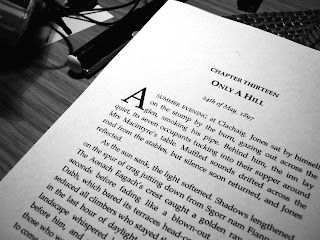My experience so far with FeedARead print on demand publishing
 |
| An early proof for the FeedARead edition |
FeedARead is an independent print on demand (POD) publisher, established with Arts Council England funding. I am using FeedARead (FAR) to produce the paperback edition of The Only Genuine Jones, a process I began several weeks ago. I thought I would take this opportunity to give an account of my dealings with this publisher for the benefit of other authors who are thinking about going down this route.
Firstly, why use FeedARead and not one of the more usual POD firms such as Lulu or Createspace? I chose FAR on the personal recommendation of other authors, and was put off Lulu and Createspace by tales of poor printing quality, delays, and pricing irregularities some authors had experienced with those firms. FAR also appears to offer greater flexibility and a higher royalty rate.
So far my interactions with the publisher have been extremely positive and communication has been prompt. The process began with design and typesetting the interior of the book. FAR provide Microsoft Word templates for two different book sizes, 5’x8′ or 6’x9′. I chose the latter due to the length of my novel. I spent about a week converting the raw text file into a Word proof; this involved paragraph and line layout, font selection, gutter margins, addition of correctly formatted headers and drop caps, and the necessary extra matter (TOC, copyright page, etc.) There are professionals you can pay to do this work for you, but I’m interested in typography and design so decided to do it myself. With an abundance of free reference material available on the Web it certainly isn’t impossible to learn the necessary skills, but as with all things in indie publishing, if you don’t think you can make it look professional then it’s always best to pay someone who can.
At this stage I also created the illustrations for the book, a process I discussed in this blog post. I found it was very important to scan the images at the highest possible resolution, clean using Photoshop, and embed at 300dpi. Only monochrome images are supported by FeedARead for interior illustrations.
The end product is a PDF file which has to be uploaded to FAR’s website. However, mine totalled around 70MB which was too large for the website to handle, so I emailed the team and was able to transfer the file to them directly. The team then uploads a ‘dummy’ file to your entry on the site which has the same number of pages as your manuscript. I must admit, it was a little baffling logging into the site and seeing a dummy file in place instead of my own manuscript, but I have been assured that it will be substituted for the genuine proof I supplied when the book goes to the printers.
During the email conversation every question I asked was answered promptly and clearly. No complaints whatsoever there.
Cover creation is the next stage. I already had a front cover, but nothing for the spine or the back. The necessary width of the spine image is calculated automatically when you upload your proof (or if the dummy file is in place), although you can figure it out yourself beforehand if necessary. At first I wanted to use a spine image with a contrasting colour to the front and back, but I was advised that this is a bad plan due to manufacturing tolerances (sometimes the spine is printed slightly off-centre, so a contrasting spine will look sloppy; best for it to blend in with the front and back).
I created the spine and back cover images myself. Here is the blog post about my experience creating the final cover.
Once the interior and cover are in place, you are prompted to confirm pricing details (I chose £7.99) and whether or not you wish to approve distribution to retailers such as Amazon (which costs £88). I emailed the team to ask about this; they assured me that you can approve distribution at any stage, although it takes several weeks to take effect. For now I am keeping the book private as I have a specific timescale I need to stick to. I need to order a batch direct from the company before the book goes on sale.
Lastly, authors are required to order a copy of the book to check it through before it can be ordered by customers. This isn’t free (every POD publisher is the same in this regard) although authors can order their own books at a heavily discounted price.
I am now waiting for my proof copy of OGJ to arrive, and will be writing more to let you all know how it looks!
Alex Roddie Newsletter
Join the newsletter to receive the latest updates in your inbox.



